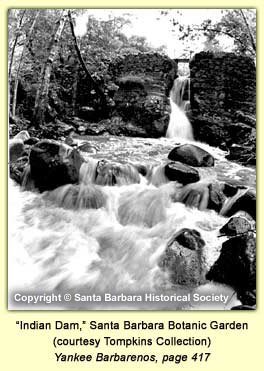The recorded history of Santa Barbara
commenced in 1542 when two small ships entered the Santa Barbara
Channel. It was only fifty
years after the first voyage of Columbus, and already the Spanish
Kingdom was reaching into new territory hoping to add even more treasure
to the royal vaults. Juan Rodríguez Cabrillo, leader of this
expedition, died while his ships paused here, but his grave, believed
to be on San Miguel Island, has never been found.
[Myrick summarizes the intervening years leading up to the 1700s and briefly takes
the reader through that century, touching on the establishment of the
Santa Barbara Mission and Presidio.]
 .
. . Walker Tompkins has focused his historical review of Santa Barbara
County on that period of time after the mission and presidio ceased
to be functioning enterprises. His book spans approximately 125 years
to end with the calamitous earthquake of 1925 that changed the city
and surroundings in so many ways. .
. . Walker Tompkins has focused his historical review of Santa Barbara
County on that period of time after the mission and presidio ceased
to be functioning enterprises. His book spans approximately 125 years
to end with the calamitous earthquake of 1925 that changed the city
and surroundings in so many ways.
Walker Tompkins, a warm, congenial person, introduced local history to Santa
Barbara residents through his newspaper column and radio talks. Walker was
a good listener and gathered many choice colorful items from his audience.
Stories of the life and times of the people during the 1830s and 1840s—the “splendid
idle 40s”—have left an impression that life in Santa Barbara, particularly
for large ranch owners, was the closest thing to nirvana. Yet, in reading the
chapters in Tompkins’ book, we learn about highway robbers, Indian uprisings,
and the fear of a repetition of pirate attacks such as the one in 1818 that
terrorized the defenseless community.
. . .Future authors have the advantage of Walker A. Tompkins’ The Yankee
Barbareños as a chronological starting point. They are also fortunate
to be able to call upon the resources and the knowledge of dedicated people
of the Santa Barbara Historical Society, the Santa Barbara Public Library,
the University of California Library, and other places to complete their works.
David F. Myrick |






